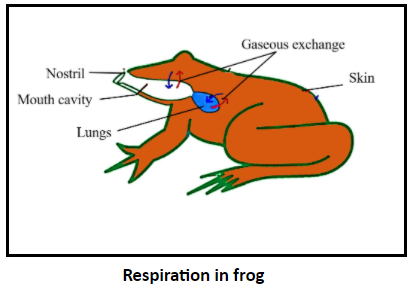Answer
396.6k+ views
Hint: Frogs can live both on land and in freshwater and belong to class Amphibia of phylum Chordata. They respire on land and in the water by using two different methods with the help of different organs meant for that. Gills are absent in adult frogs, so they diffusion method in water and land also.
Complete answer:
On land, the buccal cavity, skin, and lungs act as the respiratory organs in an adult frog. In water, skin acts as a respiratory organ in adult frogs, this is called cutaneous respiration. The respiration by the lungs is called pulmonary respiration. While living on land a frog may also breathe much like a human, by taking air in through their nostrils and down into their lungs but the mechanism is slightly different.
Additional Information:
-To draw air into its mouth, the frog lowers the ground of its mouth, which causes the throat to expand.
-Then the nostrils open allowing air to enter the mouth. The nostrils then close and therefore the air within the mouth is forced into the lungs by contraction of the ground of the mouth.
-To eliminate the ${ CO }_{ 2 }$ within the lungs the ground of the mouth moves down, drawing the air out of the lungs and into the mouth.
-Finally, the nostrils are opened and the floor of the mouth moves up pushing the air out of the nostrils.
-The skin consists of thin membranous tissue that's quite permeable to water and contains an outsized network of blood vessels.
-The thin membranous skin allows the respiratory gases to readily diffuse directly down their gradients between the blood vessels and therefore the surroundings.

So, the correct answer is 'on land skin, buccal cavity'.
Note: -Mucous glands in the skin keep the frog moist when the frog is out of the water which helps absorb dissolved oxygen from the air.
-Frogs also have a respiratory surface through which gas exchange takes place readily. This surface is on the lining of their mouth.
-While at rest, this process is their predominant form of breathing, only fills the lungs occasionally. This is because the lungs are poorly developed that are present only in adult frogs.
Complete answer:
On land, the buccal cavity, skin, and lungs act as the respiratory organs in an adult frog. In water, skin acts as a respiratory organ in adult frogs, this is called cutaneous respiration. The respiration by the lungs is called pulmonary respiration. While living on land a frog may also breathe much like a human, by taking air in through their nostrils and down into their lungs but the mechanism is slightly different.
Additional Information:
-To draw air into its mouth, the frog lowers the ground of its mouth, which causes the throat to expand.
-Then the nostrils open allowing air to enter the mouth. The nostrils then close and therefore the air within the mouth is forced into the lungs by contraction of the ground of the mouth.
-To eliminate the ${ CO }_{ 2 }$ within the lungs the ground of the mouth moves down, drawing the air out of the lungs and into the mouth.
-Finally, the nostrils are opened and the floor of the mouth moves up pushing the air out of the nostrils.
-The skin consists of thin membranous tissue that's quite permeable to water and contains an outsized network of blood vessels.
-The thin membranous skin allows the respiratory gases to readily diffuse directly down their gradients between the blood vessels and therefore the surroundings.

So, the correct answer is 'on land skin, buccal cavity'.
Note: -Mucous glands in the skin keep the frog moist when the frog is out of the water which helps absorb dissolved oxygen from the air.
-Frogs also have a respiratory surface through which gas exchange takes place readily. This surface is on the lining of their mouth.
-While at rest, this process is their predominant form of breathing, only fills the lungs occasionally. This is because the lungs are poorly developed that are present only in adult frogs.
Recently Updated Pages
How do you arrange NH4 + BF3 H2O C2H2 in increasing class 11 chemistry CBSE

Is H mCT and q mCT the same thing If so which is more class 11 chemistry CBSE

What are the possible quantum number for the last outermost class 11 chemistry CBSE

Is C2 paramagnetic or diamagnetic class 11 chemistry CBSE

What happens when entropy reaches maximum class 11 chemistry JEE_Main

Calculate the volume occupied by 88 gram of CO2 at class 11 chemistry CBSE

Trending doubts
Difference Between Plant Cell and Animal Cell

Difference between Prokaryotic cell and Eukaryotic class 11 biology CBSE

Fill the blanks with the suitable prepositions 1 The class 9 english CBSE

Change the following sentences into negative and interrogative class 10 english CBSE

Summary of the poem Where the Mind is Without Fear class 8 english CBSE

Give 10 examples for herbs , shrubs , climbers , creepers

Write an application to the principal requesting five class 10 english CBSE

What organs are located on the left side of your body class 11 biology CBSE

What is the z value for a 90 95 and 99 percent confidence class 11 maths CBSE



